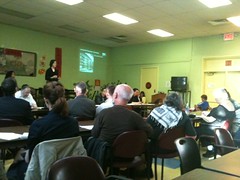 Grace Maalouf Kate Daly, executive director of New York’s Landmarks Preservation Commission, speaks earlier tonight at an informational meeting about two new proposed historic districts in the East Village.
Grace Maalouf Kate Daly, executive director of New York’s Landmarks Preservation Commission, speaks earlier tonight at an informational meeting about two new proposed historic districts in the East Village.The Landmarks Preservation Commission presented its plans tonight for creating a historic district in the neighborhood and heard from several community groups who voiced their support for the measure and also suggested extending the districts.
The presentation, which occurred during an informational meeting at the BRC Senior Services Center hosted by Community Board 3, is one of the first in a series of steps that would mean property owners in the designated areas would need commission approval before making changes to their buildings.
Kate Daly, executive director of the commission, said she has been meeting and will continue to meet with individual property owners whose buildings will fall into the designated districts, and stressed that Thursday’s meeting was merely to “get the word out to the larger community.”
She added that the commission is “very eager to move forward” in the designation process, and that the two historic districts proposed are just the beginning for the Lower East Side.
Preservationist groups, including the Greenwich Village Society for Historic Preservation, the East Village Community Coalition, the Historic Districts Council, and the Lower East Side Preservation Initiative, called on the commission to include two additions to the historic district — one between First and Second Streets and First and Second Avenues, and the other just east of Tompkins Square Park between Seventh and 11th Streets. In a signed letter, they said the proposed additions included “some critical historic resources and streetscapes.”
Elizabeth Finkelstein, a member of the Greenwich Village Society for Historic Preservation, said at the meeting that the extensions help “tell the significant story” of the immigrant history of the East Village. Richard Moses, a member the Lower East Side Preservation Initiative, agreed, saying the new historic districts would be milestones and a “nationally significant designation” since immigration is “something that defines our country.”
 Grace Maalouf The Community Synagogue on East Sixth Street would be included in the East Village’s new historic district.
Grace Maalouf The Community Synagogue on East Sixth Street would be included in the East Village’s new historic district.Valerio Orselli, director of the Cooper Square Mutual Housing Association, expressed a concern about maintaining affordable housing in the neighborhood.
“We need to think about the people who live in the buildings,” he said, requesting that the commission to look into how low-income housing could keep from incurring additional costs for any changes. He also called on the commission to reconsider the name of the neighborhood, using Lower East Side instead of East Village as it was historically called the former. His concern was echoed by some members of the Community Board.
Other groups in support of the proposal included The Bowery Alliance of Neighbors, who along with Mr. Orselli requested that the commission consider adding the Bowery to the protected areas.
Presenting the commission’s research and plans about the districts, commission member Mary Beth Betts highlighted the area’s history of immigration and how shifts in immigrant communities affected and were affected by the neighborhood buildings. The neighborhood has a “rich history of social activism” tied to its buildings, she said, and the designated districts would preserve those buildings for future generations.
The commission’s next step is to calendar a hearing, which may take place in June or July, after which the full commission would vote on whether to approve the new historic districts.



